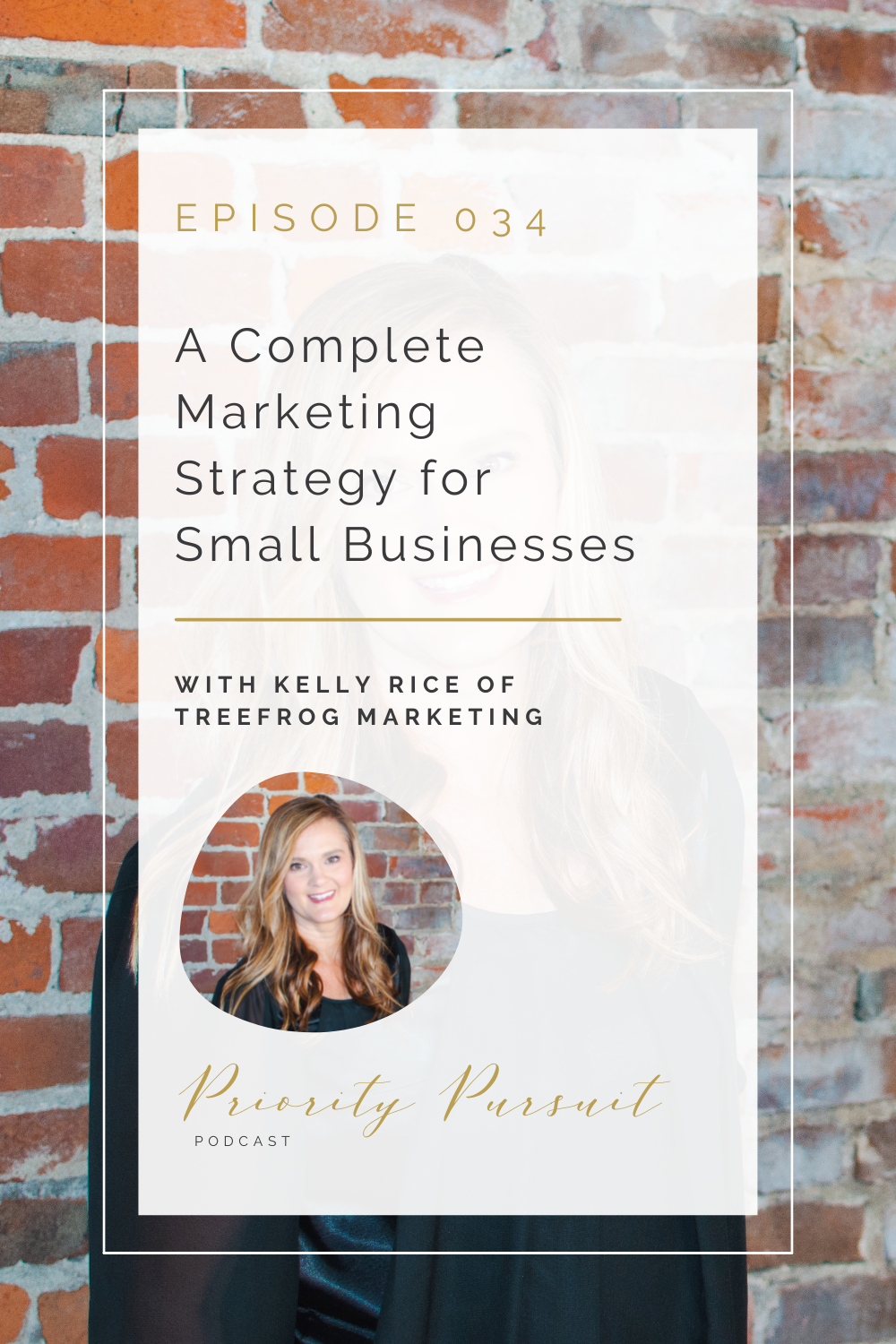Let's Connect!
Check Out Wedding Photography Packages]
I understand how much your wedding photos mean to you and how much work you’re putting into planning every last detail of your big day. As a VRP bride, you can relax and enjoy your wedding day knowing you’ve chosen a team of photographers who are just as detail-oriented as you are, will put thought into every shot, and will pay attention to all of the little details to ensure that you and your spouse love your wedding photos.
And, I’m an Indy wedding photographer for the type-A bride.
I'm Victoria Rayburn
Hey there!
Episode 034: A Complete Marketing Strategy for Small Businesses with Kelly Rice of Treefrog Marketing
Spotify | Apple Podcasts | Stitcher
As a small business owner and creative entrepreneur, do you truly understand how to market your business?
I mean, I don’t know about you, but whenever I scroll through Instagram, my podcast feed, or even my inbox, I feel like I’m hit with countless marketing ideas and tactics. And, for a lot of small business owners, this can feel overwhelming.
Afterall, which tactics actually work? How do you develop a successful marketing strategy as a small business? How do you ensure the time you dedicate to marketing your business is time and energy well spent? And, how do you market your business in a way that actually leads to more money?
Thankfully, in this week’s episode of Priority Pursuit, Treefrog Marketing Founder and Chief Marketing Strategist Kelly Rice is sharing a three-step marketing strategy that is proven to work for small businesses of all kinds.
Located in Lafayette, Indiana, Treefrog Marketing is a marketing agency that specifically works with small businesses. Since 2000, Kelly and her team have been helping small businesses grow and increase their revenue through science-based marketing protocols that work.
While I highly recommend listening to this episode and downloading Treefrog’s “Three Steps to Effective Marketing” ebook for more details, below you’ll find an overview of Treefrog’s complete marketing strategy for small businesses.
1. Stop talking about yourself.
According to Kelly, when it comes to marketing your business, the first thing you need to do is stop talking about yourself (AKA your business).
While it’s often our natural instinct to talk about how our products or services can solve a potential customer’s problem, when you talk about your company and what you offer, listeners inevitably feel like they’re hearing a sales pitch. And, nobody wants to feel like they’re being sold to.
As Kelly states in her interview, “Our natural instinct when creating marketing messages is to talk about our services and accomplishments. We call this ‘what-I-can-do-for-you marketing’ or ‘authoritative messaging.’ The problem is that people make buying decisions first based on emotion, then back them up with facts. So, leading with facts about how great you are isn’t the best choice for getting your message across to prospective customers.”
Kelly argues and can prove that there’s a better way to communicate how great your business, products, or services are. But, first, you have to understand what your customers actually want and need so you can talk “to” them and not “at” them. Kelly will further explain how to do this in the next couple steps.
2. Get the brain’s attention.
Again, when you start talking about your business, the conversation, social media post, etc. will sound like a sales pitch, and no one wants to feel like they’re being sold to. However, giving potential customers the information they’re looking for will drive your ideal client to want to do business with you.
Now, as Kelly explains in this interview, in order to do this, you need to “clarify your messaging by using a little bit of science.”
Kelly contends, “The human brain is wired to NOT pay attention to the things it doesn’t deem important. When the brain gets overwhelmed, things become ‘not important’ very quickly, and [the brain] just wants to move on. But, if your messaging is clear and helpful, the brain will pay attention.
“We already know that people make buying decisions based on emotion and then back them up with facts. This is why people don’t always buy the best products and services; they buy the ones they can understand [most easily].”
As a result, Kelly argues that as small business owners, our goal should be to make it simple for people to want to do business with us.
For instance, an easy way to do this is to give potential customers’ brains an opportunity to say, “Yeah, me too!” Then, following up this story or narrative by giving them a solution to their problem or challenge (your products or services).
While you can find more examples and formulas for getting the brain’s attention in Treefrog’s ““Three Steps to Effective Marketing” ebook, here’s an example from Treefrog’s website:
“Most small businesses are spending time on marketing, but are not getting the results they want. Our proven science-based methods build marketing systems that are duplicable, save time, filter bad advice, control your overall growth, and increase quality engagement.”
Kelly argues that by structuring and opening your messaging this way, you can lead with empathy and then follow with authority, which will help your prospective customers’ brains easily determine if they want to pay attention to what you have to offer or not.
Now, not only will this kind of messaging get attention, but it will help generate more qualified leads. Because, website viewers, social media followers, or whomever you share your messaging with will be able to easily qualify themselves and decide if you’re the right fit for them.
3. Build a solid plan of action.
Now, when you saw that this Priority Pursuit episode was going to lay out a complete marketing strategy for small businesses, I’d bet you likely thought Kelly was going to talk about social media, websites, and such. And, friend, that part is coming up next!
Again, Kelly and her team have been working with small businesses since 2000. For more than two decades, they’ve designed and implemented marketing strategies for hundreds of small businesses. And, while social media algorithms may change and new outlets (such as Instagram reels) might be invented, Kelly has found and can prove that—regardless of what kind of business you run—there are four necessary elements to building an effective marketing strategy: audience, website, content, and promotion.
As Kelly shares in her interview, “When you combine all four of these foundational elements, they function as a flywheel—continually moving, impacting, and producing results.”
Audience
First of all, you have to know who your audience is so you can create what Kelly calls “customer-first messaging.” Like we’ve already discussed, this clear messaging is what’s going to help your prospective customers pay attention.
If you need more assistance identifying your ideal customer/audience and clarifying your messaging, be sure to download Treefrog’s “Three Steps to Effective Marketing” ebook.
Website
According to Kelly—and I couldn’t agree more—your website is by far your most powerful marketing tool. That said, studies show that your website has less than eight seconds to grab visitors’ attention and, as Kelly bluntly shares, “determine the success of all of your marketing efforts.”
During Kelly’s two decades of developing websites for small businesses, she’s found that most websites fail to convert prospects into customers because (1) users can’t quickly find what they need, (2) the site’s messaging isn’t clear, and (3) users aren’t sure what they need to do next.
To combat these problems, Kelly argues that your website should include:
-
- A Clear Header Section: At the very top of your website (above the fold), you need to include a header that explains “who you are, what you do, how you can help people, and what they need to do next.”
- Body Sections That Help You Connect With Users: You’ll likely have various body paragraphs and sections on your home page, and each of these sections needs to help you connect with users emotionally, detail what they should expect, show them how you can help them through your products or services, and allow others (your past and current clients) to tell them how wonderful you are through testimonials.
- A Closing Section That Drives Action: Last but not least, your website needs to make whatever action you want users to take clear. The closing section of your website is a great place to make the next step clear. For instance, Kelly recommends including a form in the closing section of your home page or a service page so people schedule a consultation.
According to Kelly, “Your goal is to make connecting with your company and resources as easy as possible. You don’t want their brains to have to do a ton of work to determine if it should pay attention or not.” And, if you know your audience and your message is clear, your website will make it easy for your ideal customer to want to work with you.
If you’d like more information about exactly what should be included on your website, download Treefrog’s “Three Steps to Effective Marketing” ebook.
Content
Next, you need to think about content, and in this episode, Kelly is specifically talking about the content that lives and is hosted on your website (blogs, videos, downloads, etc.).
As Kelly shares in her interview, “Content marketing is based on the understanding that people want to interact with the information they want—not what you want them to know.” As a result, your goal is to attract customers by creating content that is “relevant and helpful, not interruptive.”
Blogs, videos, downloads, and whatever other content you produce should make your ideal client curious, help them feel informed, and bring them one step closer to wanting to work with you.
Promotion
The final element in Treefrog’s flywheel marketing strategy is promotion. And, as Kelly says, “This is where most organizations fall short.”
Just adding new content to your website won’t help you reach new potential customers. Instead, you have to get the content in front of them.
According to Kelly, “Your goal is to get your lead-generating content in front of your best prospects with little to no effort on their part . . . This is why we use tactics such as social media, Google Ads, and strategic emails to attract and lead prospects to your website and resources.”
Now, where you promote your content should be determined by your audience, as you want to promote your content or services wherever your best customers are hanging out online.
For example, if you’re a business-to-business company, you would likely want to focus your efforts within LinkedIn and perhaps Facebook. But, if you’re a wedding photographer, you’ll likely find that Instagram is where you should be promoting most of your content.
Basically, figure out where your customers are online, and promote your content there.
This is a lot of information, but when it comes to creating a complete marketing strategy for your small business, here’s what you need to do:
“In order to generate growth, you need to develop your audience identification strategy that clarifies your messaging and then create a lead-generating website. Next, you’ll use social media and other promotional tools to drive people to the strategic content on your website—which is developed to lead people to do the thing you want them to do.”
Want more information about Treefrog’s flywheel marketing approach? Download their “Three Steps to Effective Marketing” ebook!
Want to hear more from Kelly & Treefrog Marketing?
Kelly Rice and her team are a wealth of strategic marketing wisdom. If you’d like to hear more from Kelly and the Treefroggers, follow them on Instagram and Facebook and check out their blog—which is full of marketing resources for small business owners.
Or, if you’re interested in learning more about Treefrog’s services and potentially outsourcing your marketing, visit Treefrog’s website. With Treefrog’s small business digital marketing services, Treefrog could actually maintain your entire marketing flywheel for you!
Links & Resources Mentioned in This Episode
“Three Steps to Effective Marketing” Ebook
Treefrog’s Small Business Digital Marketing Service
“Episode 008: How to Define & Communicate Your Brand Position with Nathan Holritz”
Building a Story Brand by Donald Miller
Join the Priority Pursuit Podcast Facebook Community
Save $50 on Your First Order from KISS Books of $100 or More
Save 50% on Your First Six Months of Quickbooks Self-Employed
Receive 50% Off Your First Order with Photographer’s Edit
Did you enjoy this episode? If so, pin it to save it for later! Follow me on Pinterest for more marketing, business, branding, and boundary-setting strategies!

Let's Connect!
Check Out Wedding Photography Packages]
I understand how much your wedding photos mean to you and how much work you’re putting into planning every last detail of your big day. As a VRP bride, you can relax and enjoy your wedding day knowing you’ve chosen a team of photographers who are just as detail-oriented as you are, will put thought into every shot, and will pay attention to all of the little details to ensure that you and your spouse love your wedding photos.
And, I’m an Indy wedding photographer for the type-A bride.
I'm Victoria Rayburn
Hey there!
© 2023 Victoria Rayburn Photography. All rights reserved. | Terms & Conditions | Privacy Policy
Let's Connect!
@victorialrayburn
Let's Connect! | @victorialrayburn
Schedule a Coffee Date
However, as a VRP bride, you can relax and enjoy your celebration while being confident that every moment and detail is being thoughtfully photographed!

